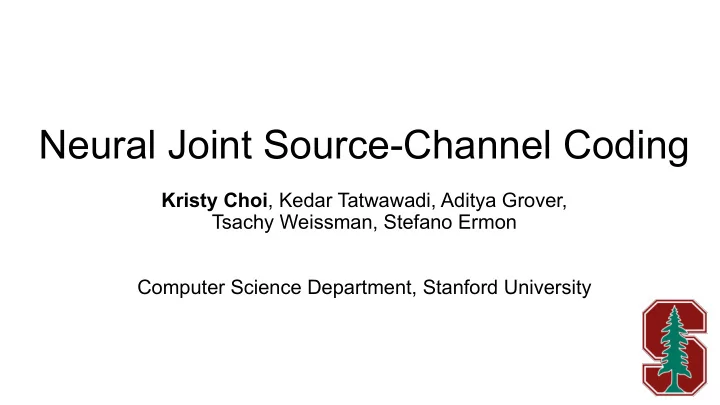

Neural Joint Source-Channel Coding Kristy Choi , Kedar Tatwawadi, Aditya Grover, Tsachy Weissman, Stefano Ermon Computer Science Department, Stanford University
Motivation Reliable, robust, and efficient information transmission is key for everyday communication
Problem Statement Channel coding Channel decoding 0 1 0 1 1 0 0 1 1 1 1 0 channel model Compression (Source coding) Decompression Separation Theorem [Shannon 1948] Assumes infinite blocklength & compute Reliable communication across noisy channel
Neural Joint Source-Channel Coding 0 1 1 0 1 1 1 0 channel model Neural joint Neural joint source-channel source-channel encoder decoder Learn to jointly compress and channel code
NECST Model 0 1 1 0 1 1 1 0 channel model encoder decoder Maximize mutual information [MacKay 2003]
Coding Process 0 1 1 0 1 1 1 0
Learning Objective • Mutual information maximization • Y should capture as much information about X as possible, even after corruption! • Estimation is hard ☹ [Barber & Agakov 2004] • Variational lower bound is nicer: [Kingma & Welling 2014] [Vincent 2008] Reconstruction loss!
Optimization Procedure • Our latent variables y are discrete ☹ • Use VIMCO: [Mnih and Rezende 2016] • Draw multiple ( K ) samples from inference network, get tighter lower bound Multiple samples of y Multiple reconstruction loss terms
Fixed Rate: Comparison vs. Ideal Codes We need a much smaller number of bits to get the same level of distortion, even vs. WebP [Google 2010] + ideal channel code
Extremely Fast Decoding Up to 2x orders of magnitude in speedup on GPU vs. LDPC decoder [Gallager 1963]
Learning the Data Distribution 0 1 1 1 0 1 0 0 1 Theorem (informal): NECST learns an implicit model of
Robust Representation Learning 1) Encoded redundancies: 1 1 1 0 1 1 interpolation in latent space by bit-flip 0 bit flips 1 bit flip 45/100 bits 2) Improved downstream classification: improves accuracy by as much as 29% across variety of classifiers when inputs are corrupted by noise!
Summary • End-to-end deep generative modeling framework for the JSCC problem • Better bitlength efficiency than separation scheme on CIFAR10, CelebA, SVHN • Another way to learn robust latent representations • Get an extremely fast decoder for free
Thanks! Kedar Tatwawadi Aditya Grover Stefano Ermon Tsachy Weissman Contact: kechoi@stanford.edu Code: https://github.com/ermongroup/necst Poster #165: Tuesday, June 11th @ Pacific Ballroom
Recommend
More recommend